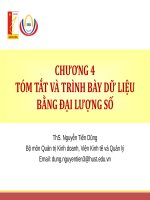Lectures Marketing management: Chapter 9 - ThS. Nguyễn Tiến Dũng
Bạn đang xem bản rút gọn của tài liệu. Xem và tải ngay bản đầy đủ của tài liệu tại đây (774.57 KB, 32 trang )
CHAPTER 9
CREATING BRAND EQUITY
Nguyen Tien Dung, MBA
Email:
Chapter Questions
1. What is a brand, and how does branding
work?
2. What is brand equity?
3. How is brand equity built, measured, and
managed?
4. What are the important brand architecture
decisions in developing a branding
strategy?
© Nguyễn Tiến Dũng
2
Main Contents
1. What Is Brand Equity?
2. Building Brand Equity
3. Measuring Brand Equity
4. Managing Brand Equity
5. Devising a Branding Strategy
6. Customer Equity
© Nguyễn Tiến Dũng
3
1. What Is Brand Equity?
● The Role of Brands
● The Scope of Branding
● Defining Brand Equity
● Brand Equity Models
© Nguyễn Tiến Dũng
4
The Role of Brands
● Show the source or maker of a product and
allow customers to assign responsibility for its
performance to a particular manufacturer or
distributor.
● Perform valuable functions for firms
● Simplify product handling or tracing.
● Help to organize inventory and accounting records.
● Get the protection from the government for unique
features or aspects of the product: registered
trademarks, patents, packaging can be protected
through copyrights and proprietary designs.
● Signals a certain level of quality
© Nguyễn Tiến Dũng
5
The Scope of Branding
● A physical good
● A service
● A store
● A person
● A place
● An organization (U2 or American Automobile
Association)
● An idea (abortion rights or free trade)
© Nguyễn Tiến Dũng
6
Defining Brand Equity
● The added value endowed on products and
services.
● It may be reflected in the way consumers think,
feel, and act with respect to the brand, as well
as in the prices, market share, and profitability
the brand commands.
● Customer-based brand equity is the
differential effect brand knowledge has on
consumer response to the marketing of that
brand.
● It could be positive or negative
© Nguyễn Tiến Dũng
7
Brand Equity Models
● BrandAsset® Valuator
● BrandZ
● Brand Resonance Model
● InterBrand
© Nguyễn Tiến Dũng
8
BrandAsset Valuator
© Nguyễn Tiến Dũng
9
© Nguyễn Tiến Dũng
10
BrandZ
● Presence. Active familiarity based on past trial,
saliency, or knowledge of brand promise
● Relevance. Relevance to consumer’s needs, in
the right price range or in the consideration set
● Performance. Belief that it delivers acceptable
product performance and is on the consumer’s
short-list
● Advantage. Belief that the brand has an
emotional or rational advantage over other
brands in the category
● Bonding. Rational and emotional attachments
to the brand to the exclusion of most other
brands
© Nguyễn Tiến Dũng
11
BrandDynamics Pyramid
© Nguyễn Tiến Dũng
12
Brand Resonance Pyramid
© Nguyễn Tiến Dũng
13
2. Building Brand Equity
● Choosing Brand Elements
● Designing Holistic Marketing Activities
● Leveraging Secondary Associations
● Internal Branding
● Brand Communities
© Nguyễn Tiến Dũng
14
Leveraging Secondary Associations
© Nguyễn Tiến Dũng
15
A Brand Community
● A specialized community of consumers and
employees whose identification and activities
focus around the brand.
● Three characteristics identify brand
communities:
● A “consciousness of kind” or sense of felt connection
to the brand, company, product, or other community
members;
● Shared rituals, stories, and traditions that help to
convey the meaning of the community; and
● A shared moral responsibility or duty to both the
community as a whole and individual community
members.
© Nguyễn Tiến Dũng
16
3. Measuring Brand Equity
● Brand Value Chain
● Approaches to measure BE
© Nguyễn Tiến Dũng
17
Brand Value Chain
© Nguyễn Tiến Dũng
18
InterBrand Valuation Method
© Nguyễn Tiến Dũng
19
Approaches to measure BE
● A brand audit is a consumer-focused series of procedures to
assess the health of the brand, uncover its sources of brand
equity, and suggest ways to improve and leverage its equity.
● Conducting brand audits on a regular basis, such as annually,
allows marketers to keep their fingers on the pulse of their brands
so they can manage them more proactively and responsively.
● Brand-tracking studies collect quantitative data from
consumers over time to provide consistent, baseline information
about how brands and marketing programs are performing.
● Tracking studies help us understand where, how much, and in
what ways brand value is being created, to facilitate day-to-day
decision making.
© Nguyễn Tiến Dũng
20
4. Managing Brand Equity
● Brand Reinforcement
● Brand Revitalization
© Nguyễn Tiến Dũng
21
5. Devising a Branding Strategy
● Branding Decisions
● Brand Portfolios
● Brand Extensions
© Nguyễn Tiến Dũng
22
6. Customer Equity
● Customer lifetime value is affected by revenue
and by the costs of customer acquisition,
retention, and cross-selling.
● Acquisition depends on the number of
prospects, the acquisition probability of a
prospect, and acquisition spending per
prospect.
● Retention is influenced by the retention rate
and retention spending level.
● Add-on spending is a function of the efficiency
of add-on selling, the number of add-on selling
offers given to existing customers, and the
response rate to new offers.
© Nguyễn Tiến Dũng
23
P&G’s brands
© Nguyễn Tiến Dũng
24
Positioning
Act of designing the company’s
offering and image to occupy
a distinctive place in the mind of
the target market.
© Nguyễn Tiến Dũng
25









